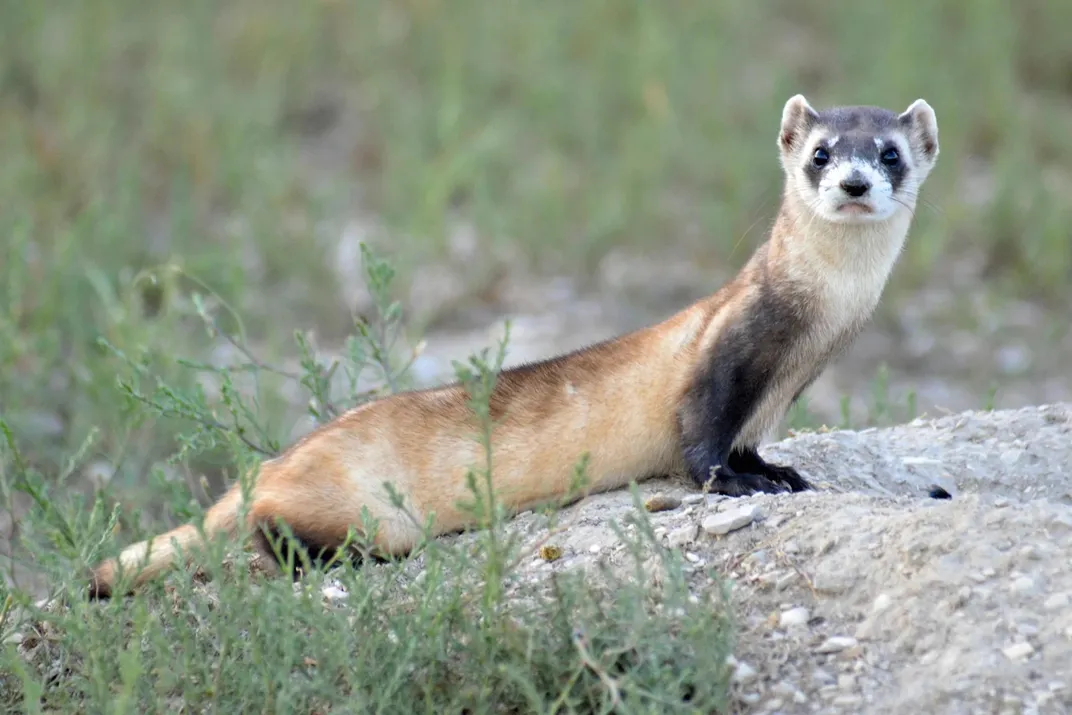Six Animals the Smithsonian Has Helped Save From Extinction
For more than a century, the Institution has placed a scientific focus on studying and conserving threatened species
:focal(700x350:701x351)/https://tf-cmsv2-smithsonianmag-media.s3.amazonaws.com/filer_public/65/f4/65f4bc26-4929-4a3b-a359-54618e1f70d8/bison-010.jpg)
From small mammals to crustaceans, tiny amphibians to flightless birds, there are over one million animal species described on Earth, and millions more we don’t know about. With so many animals, many are bound to go extinct, and humans can speed up the process. But through scientific ingenuity, international cooperation, and pure determination, the global scientific community is conserving biodiversity across the planet. Here are six animals the Smithsonian has helped save from the brink of extinction:
1. American Bison
/https://tf-cmsv2-smithsonianmag-media.s3.amazonaws.com/filer_public/62/90/6290d45b-3702-4fb3-adf4-5002f39779b0/bison-on-the-mall.jpeg)
Before he founded the Smithsonian’s National Zoo in 1888, William Temple Hornaday served as a taxidermist for the U.S. National Museum. He was also an avid hunter and explorer of the American West. In 1886, Hornaday embarked on a collecting trip to Montana on behalf of the National Museum, where he was horrified to find that the magnificent American bison was facing extinction, having been slaughtered in large numbers as settlement moved West.
The trip converted him from hunter to conservationist: he secured a small breeding herd and brought it back to Washington, D.C. to bring attention to the species. He put bison on display in the South Yard of the Castle (the current location of the Enid A. Haupt Garden), and their popularity led to the founding of the Zoo as part of the Smithsonian in 1888. Hornaday was appointed as its first director. Ever the prolific and dramatic writer, Hornaday is credited with galvanizing national concerns about the extinction of the bison and other species native to North America.
Today, the Zoo is working hard to restore the American bison population to the American Prairie Reserve in Montana. In 2022, Zoo scientists found that restoring the bison not only supports the prairie ecosystem, but it also improves food security and food sovereignty for Native Nations in the area. Two bison are currently on display at the National Zoo in D.C., serving as ambassadors for their brethren out west.
2. Golden Lion Tamarins
/https://tf-cmsv2-smithsonianmag-media.s3.amazonaws.com/filer_public/3f/2d/3f2d4dca-63ca-420b-9730-1d587649ac2b/nzp-20180807-159sb_tamarin.jpeg)
In 1972, golden lion tamarins were facing extinction. It was estimated that there were only about 200 individuals left in the wild, and captive birth rates were low. Research zoologist Dr. Devra Kleiman, a recent hire at the Zoo, established the Golden Lion Tamarin Conservation Program, which ultimately became a partnership of many conservation organizations and zoos. In 1984, the Smithsonian released eight golden lion tamarins into Reserva Biológica de Poço das Antas in Brazil, the first step in restoring the species’ population in the country. A recent survey found that the population has reached an all-time high of 4,800—and nearly half are descended from the introduced tamarins.
3. Black-footed Ferrets

Black-footed ferrets once ranged throughout the North American Great Plains, making them North America’s only native ferret species. They were thought to be extinct in 1979, until a small population was discovered in 1981 on the Wyoming prairie. Scientists caught the last remaining wild black-footed ferrets—18 of them—to establish a breeding center in Wyoming. By 1988, the population grew considerably, and the Smithsonian’s National Zoo and Conservation Biology Institute in Front Royal, Virginia and Omaha’s Henry Doorly Zoo in Nebraska joined the breeding program. The next year, six ferret kits were born in Front Royal, the first ferrets born in human care outside of Wyoming. All black-footed ferrets alive today are related to the original 18 animals brought into the breeding program in 1981.
Every year the Smithsonian Conservation Biology Institute supports a genetic assessment of all the black-footed ferret individuals that are cared for by humans. And, working with the U.S. Fish and Wildlife Service, the Zoo has introduced several hundred ferrets to the wild.
4. Panamanian Golden Frogs
/https://tf-cmsv2-smithsonianmag-media.s3.amazonaws.com/filer_public/b4/65/b465d39f-6ed9-42bf-8827-9b0b78c297e2/goldenfrog_species.jpg)
The Panamanian golden frog is critically endangered and may be functionally extinct in the wild. Amphibians like these are dying off in large numbers across the globe not just because of typical stressors such as habitat loss, climate change, and pollution, but also because of the deadly amphibian chytrid fungus.
Smithsonian scientists are working to save the Panamanian golden frog and other amphibians from this lethal infection. In 2008, the Zoo partnered with the Smithsonian Tropical Research Institute and others to build a facility in Gamboa, Panama to safeguard amphibians at risk of extinction from the fungus. The project houses a living collection of critically endangered amphibians and is actively focused on sustaining the living collection and restoring wild populations of these frogs.
5. Blue Crabs
/https://tf-cmsv2-smithsonianmag-media.s3.amazonaws.com/filer_public/a0/d6/a0d6c93a-c15f-4ac5-a140-c06214a2b528/sercbluecrab2.jpg)
Even if a species isn't facing a global extinction, its collapse in one region could wreak havoc on a local community's economy and cultural identity. The blue crab population in the Chesapeake Bay, for instance, is central to many Maryland residents' way of life. But after four decades of plenty, blue crab numbers in the Bay plummeted in the early 1990s. Prices soared, and local restaurants were forced to import crab meat from other states and even southeast Asia—a blow to the region’s identity and economy. By 2008, the White House declared the blue crab fishery a federal disaster. Managers faced a dilemma—how to sustainably keep the tradition of the Bay waterman alive.
Fortunately, the Smithsonian Environmental Research Center had been tracking blue crab populations since 1981. Scientists discovered that from 2000 on, not enough baby crabs were emerging in the Bay to sustain the population; there weren’t enough adult females left to spawn them. Meanwhile, up to 80 percent of Virginia’s catch and more than half of Maryland’s consisted of females, demonstrating the harmful impact of overfishing. The data showed that saving the fishery depended on protecting adult females, and it led both Maryland and Virginia to reduce female harvests in 2008. The next two years saw a sharp rebound.
6. Scimitar-horned Oryx
/https://tf-cmsv2-smithsonianmag-media.s3.amazonaws.com/filer_public/d2/d0/d2d099ae-b67e-4c37-ae15-270ea6f4c769/oryx_si.jpeg)
Twenty-three years after being declared “extinct in the wild,” the scimitar-horned oryx has made a remarkable comeback. In December 2023, following decades of conservation efforts, the International Union for Conservation of Nature downlisted the scimitar-horned oryx as “Endangered.”
In 2013, the Environment Agency–Abu Dhabi (EAD), inspired by the conservation legacy of the late Sheikh Zayed bin Sultan Al Nahyan, established a partnership with the Chadian government and the nonprofit organization Sahara Conservation to reintroduce scimitar-horned oryx into Chad. The leadership and support provided by a range of international partners, including the Zoo, have enabled the release of nearly 300 scimitar-horned oryx since 2016.
The Smithsonian has played technical and scientific roles in the reintroduction program in Chad, monitoring the animals after they’ve been released through the Movement of Life program (which tracks many different animal species). Everything the team learns about oryx behavior by tracking them feeds into animal management, the reserve’s management, and future reintroduction practices.
The Work Continues
From the small to the large, each species contributes something important to the vast biodiversity of our planet. While the Smithsonian celebrates every conservation victory, our scientists know the job is never truly done. Most species need ongoing care and attention to ensure their populations continues to grow and thrive in this changing world. As part of this process, scientists at the Smithsonian Environmental Research Center keep an eye on several other animal species, from Olympia oysters in San Francisco to Virginia oysters in the Chesapeake Bay, while scientists at the National Museum of Natural History study freshwater mussels, koalas, and various parasite species to help decision makers determine how to conserve these animals before it’s too late. This diversity is crucial to robust ecosystems and a key contributor to the planet's long-term health.
